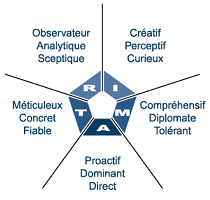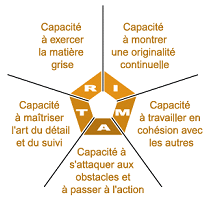

STYLES SOCIAUX
|
COMPÉTENCES
|
LEADERSHIP
|
|||||||||||||||||||||
|
|||||||||||||||||||||||
Approche intégrée aux compétences modèle TRIMA
L'approche par compétences TRIMA est un modèle qui intègre de façon cohérente et bien articulée trois dimensions qui définissent le comportement humain : le monde des préférences ou des styles sociaux, le monde des compétences et le monde de l'influence ou le style de leadership. Ces trois dimensions peuvent être mises en relation les unes avec les autres afin de prendre conscience de l'alignement stratégique qui caractérise tout individu. Plus une personne concilie les trois niveaux, plus elle se comporte avec dynamisme au travail et fait preuve de congruence avec elle-même dans ses agissements.
Figure 2

La première structure, celle des styles sociaux, définit les valeurs, les attitudes et les croyances de l'individu. Les styles sociaux renseignent sur le sens de la vie de la personne, sur ce qu'elle fait par rapport à ses préférences. Ils révèlent le concept du soi, indiquent le « pourquoi » des agissements, constituent la MOTIVATION de la personne. Tels des rails de chemins de fer, les schémas de pensée, que sont les styles sociaux, conduisent la personne dans une direction de vie déterminée.
Les domaines de compétences servent de filtres pour discriminer les capacités individuelles. Ils dessinent le contour de « à l'aide de quoi » la personne sera efficace. Ils pointent les éléments qu'une personne utilise pour sa MOBILISATION personnelle. Les domaines de compétences jouent presque toujours un rôle d'aiguillage dans le développement des compétences, ne laissant passer que ce qui est conforme à la direction des styles sociaux. Révélant le concept de l'estime de soi, ils donnent de l'information sur la personne en lien avec le « je suis capable de… »
Enfin, les styles de leadership, constituant la troisième structure, servent de forces mobilisatrices qui déterminent les zones d'influence et d'énergie. Ils fournissent des renseignements sur le type d'impact qu'un individu exerce sur son milieu et les gens qui l'entourent. Ils révèlent l'affirmation de soi ou l'expression de soi qui constituent des mises en valeur de ses ressources. Ils indiquent l'orientation du mode de pensée d'une personne, ses objectifs choisis, ses actions. Bref, ils mettent en lumière le « comment » des agissements et traduisent l'angle de la RESPONSABILISATION de la personne.
À partir d'un éventail de 120 compétences disponibles avec le modèle TRIMA, et par extrapolation lorsqu'on juxtapose une microstructure sur les autres, nous pouvons identifier, par le biais de questionnaires et entrevues, les aspects suivants chez une personne: